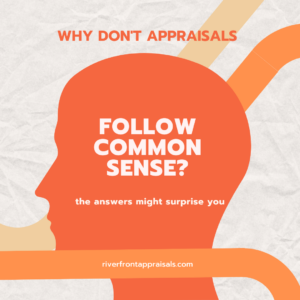
Property Taxes Just Went Up? We’ve Got You Covered!
It’s reassessment season for most folks in our area. Homeowners

Welcome to the October edition of our blog series, The Loan Officer’s Guide to Appraisals. If you’ve been following along with us, you know this is part 10 in our year-long series on appraisals and the loan officer. In this series, we’ve addressed lots of useful information about the appraisal process, and today’s post is no different. This month is all about extraordinary assumptions.
In this post, I’ll discuss what an extraordinary assumption is, how and why it’s used, and how it differs from a hypothetical condition, and finally why these assumptions are so ‘extraordinary’. Read on!
What is an extraordinary assumption?
The Uniform Standards of Professional Appraisal Practice (USPAP) defines an extraordinary assumption as “an assignment-specific assumption as of the effective date regarding uncertain information used in analysis which, if found to be false, could alter the appraiser’s opinion or conclusions.”
I’ll explain more in an example later, but what this means in English, is that if there’s ever a time I’m not sure about something in a property I’m appraising, or perhaps the neighborhood, or any number of things, I’ll assume it to be true, and label it as an extraordinary assumption. However, the use of such an assumption may affect the opinion of value or other conclusions, and that’s something we’ll also discuss more fully, later.
One thing to remember is that we can’t just throw around these assumptions for everything, Not all issues raise to the level of an extraordinary assumption. For instance, if a homeowner tells me that the roof has hail damage, I cannot make an extraordinary assumption that the roof is in good condition, because I know that to be untrue.
[bctt tweet=”the use of such an assumption may affect the opinion of value or other conclusions,” username=”RiverfrontApp”]
How and when are extraordinary assumptions used?
Let’s discuss extraordinary assumptions in more detail here, with an example of a drive-by appraisal.
An exterior-only appraisal (commonly referred to as a drive-by appraisal) is an appraisal in which the appraiser only observes the exterior of the home. This is usually done from the street only, although at times, the appraiser will actually walk around the property to observe the entire home – again – only from the exterior.
This creates a challenge for the appraiser, because we also have to analyze the interior (condition, quality, room count, etc) of the home. Since we’re not going inside the home, we consult various sources in order to give the client the best information possible. Those sources may include previous MLS listings, tax assessment records, Zillow, and the homeowner.
In my opinion and experience, none of the information we collect is as reliable as that which is given to us by the homeowner. However, there are plenty of times when the homeowner just isn’t sure about the square footage, or the age of the home, or the type of windows, etc. So whether we get our information from the tax assessor or even the homeowner, it always has the possibility of containing error. Therefore, we base our valuation and other conclusions on the extraordinary assumption that the information we received is actually factual.
Other examples include not having access to a room, building, or other area of the home or property. If I can’t access a space, I need to assume that space is similar in all respects to the rest of the home. Or that the storage barn in the back yard is in good condition inside. Also, when utilities are disconnected, I’ll make an extraordinary assumption that all utilities and systems are in average, working order. Again, I note that the use of the assumption may affect assignment results, because if found to be untrue…if the plumbing is all shot and needs to be completely redone, then that will have an affect on my value.
What’s the difference between an extraordinary assumption and a hypothetical condition?
In our last blog post , I wrote about new construction appraisals, and how we employ hypothetical condition. In that post, we said that a hypothetical condition is used when stating something that does not exist, or that the appraiser knows to be untrue. The appraiser states that the value of the proposed home is $475,000 based on the hypothetical condition that the home is already built (when it is not). So a hypothetical condition is when the appraiser states something they know is untrue, and an extraordinary assumption is when the appraiser states something that may or may not be true.
What’s so extraordinary about an extraordinary assumption?
The Appraisal Institute has written an extremely helpful article about extraordinary assumptions. If you’d like to read it in full, you can check it out by clicking [here].
What I want to point out from this article is the difference between a regular assumption (what AI calls ‘general’) and an extraordinary assumption. Both of these are used when something is assumed to be true but may not be, both may impact the conclusions and value if found to be untrue, and the appraiser must disclose both in the report.
“But”, AI states, “special/extraordinary assumptions require more conspicuous disclosure; they must be emphasized. However, in the case of a general assumption, while there is uncertainty as to whether or not the condition is true, there is no readily apparent reason why it would not be. In the case of a special/extraordinary assumption, the valuer spots a “red flag”, something that alerts the valuer to the possibility that the condition might not be true.”
Here are some examples AI used in their article to show the distinction between general and extraordinary assumptions.
“Example 1: A valuer is asked to value an improved property that may have a construction defect. The valuer observes signs of settlement, or perhaps an individual familiar with the property indicates there may be a construction defect. The value opinion reflects no defect and the appraisal is based on the special/extraordinary assumption that there is no defect.”
“Example 2: A valuer is asked to value an improved property. There is no reason to believe there are any construction defects; the valuer is not told of any and there are no readily apparent reasons to believe there are any. The appraisal report might include a general assumption that there are no construction defects.”
“In example 1, clear disclosure of the special/extraordinary assumption in the report will alert the client to the uncertainty about a possible construction defect and the fact that the value opinion does not take into account the impact of any such defect, should there be one. The client can then make the decision to investigate the situation further, or to rely on the appraisal based on the special/extraordinary assumption.”
“In example 2, there is nothing alerting the valuer to a possible problem relating to construction defects. If there were, the assumption would rise to the level of an extraordinary or special assumption.”
How does an extraordinary assumption affect my appraisal?
I’ve already mentioned that when an appraiser uses an extraordinary assumption, the appraiser must indicate that use of the assumption may affect the assignment results. Why?
For the drive-by example I used above, remember I mentioned that I’m looking at MLS records, tax records, and everything else I can get my hands on. And, I’m interviewing the homeowner (if they’re available). None of that information (usually) was collected physically myself. I didn’t measure the home. I didn’t go inside and see all the remodeling work the owner said he did last year. So I’m going to assume he’s telling the truth. I’m assuming that the tax records showing the home to be 1,800 square feet are accurate. And my conclusions, along with my final value is going to be – at least in part – based on all of this information. So, if any of the information I collect and report is not true, then my value could be affected. If that home is actually 1,500 square feet, then my value is likely too high. If the home actually only has two bedrooms when the tax records show four, my value may be affected. If the home actually has a fully finished basement and I said it was built over a crawl space, then likely my value will be too low.
The use of extraordinary assumptions is common, and can be a useful tool in the appraisal process. However, it’s important to know why they’re used, when they shouldn’t be used, and how they could affect value. When you’re lending sometimes hundreds of thousands of dollars for a home, this information is super helpful to know!
If you have any other questions about extraordinary assumptions, or anything related to real estate appraisal, email me at ryanbays@riverfrontappraisals.com.
Committed to helping you understand your home’s market value,
Ryan Bays, SRA, AI-RRS

It’s reassessment season for most folks in our area. Homeowners

I feel like we all need a laugh. How about

So this may be a slight break from the norm,
Riverfront Appraisals has been providing comprehensive valuations of residential properties to Western Kentucky and Southwestern Indiana since 2008.